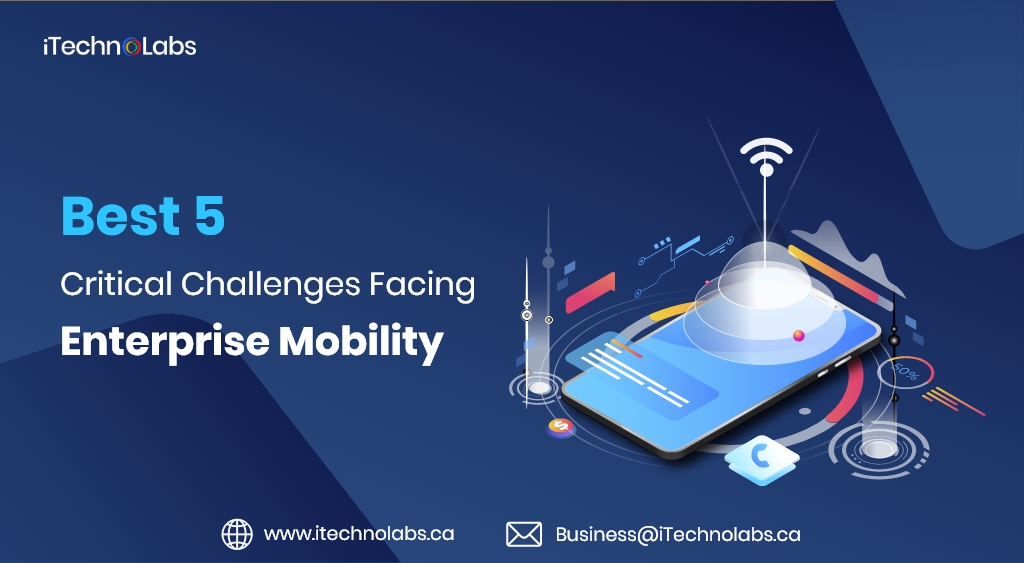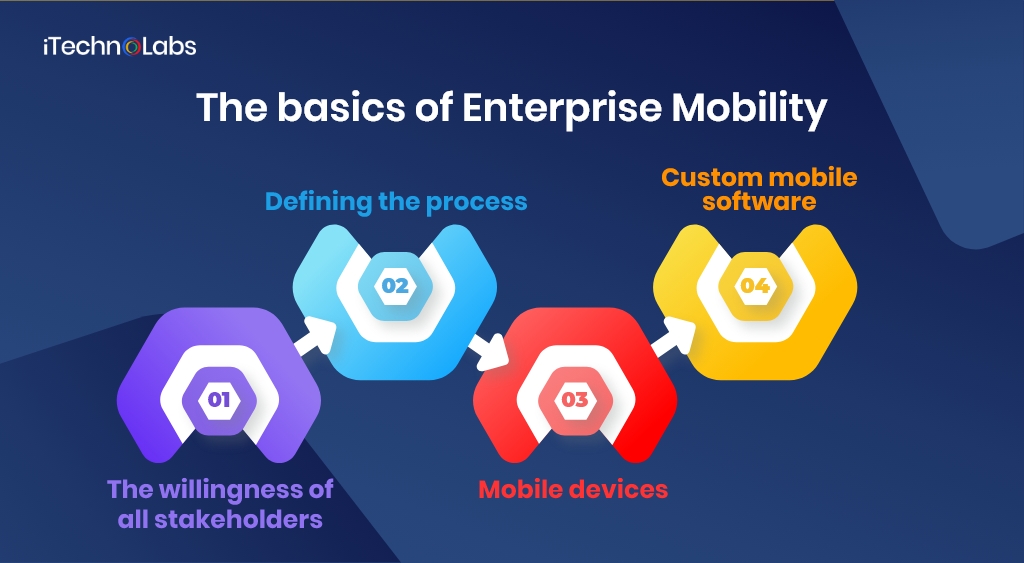Published on April 14th, 2023
A huge incline in corporate mobile usage has produced remarkable capabilities to streamline the process of working. It has enabled real-time access to government information to employees who work from remote locations and increased the bottom line of organizations through competitive advantages that stem from increased productivity of employees and satisfaction, superior customer service, and cost reduction.
However, just as the glitter that shines isn’t always gold. That’s the case with enterprise mobility management also. It’s a hot technological advancement, however, it comes with its own issues. What if, for instance, you’re required for a definition of enterprise mobility? What are the different aspects and types of it? Let’s first look at the fundamentals of it.
Table of Contents
ToggleThe basics of Enterprise Mobility
Many companies are beginning to provide their employees with mobile applications that can be used to substitute completely or in part traditional methods of doing their duties. Because of the numerous advantages of mobile services for enterprises for business and employees, this has been one of the essential elements of strategies for companies that are primarily focused on long-term growth as well as growth.
The fundamentals of enterprise-wide mobility strategies rest on four pillars that are the main ones:
1. The willingness of all stakeholders
It is vital that those who make the most important business decisions are in tune with the potential mobility or the changes in order to have an understanding of the established expectations. The commitment of the major people in the company is the base for the other parameters or foundations.
2. Defining the process
If the keyholders are aware of how important it is to implement mobile in the business It is the company’s responsibility to let them know what the business does.
3. Mobile devices
In the era of an integrated working environment, mobility devices are the primary role in implementing the same. Selecting the best device for the job determines the range of options for the whole process for the business.
4. Custom mobile software
One of the most important factors to manage mobility is an enterprise-specific mobile application. The most powerful device to replace the old method of working. It assists the business to be more efficient and makes the system of the company flexible.
What is the reason for Enterprise Mobility?
Enterprise mobility has improved efficiency and flaccidity. It has improved the efficiency of the company and has helped in cutting costs. Every business needs to be clear on a plan of management to create a top-quality structure of security and governance.
EMM viz. Enterprise Mobility Management, in simple terms, EMM is the strategy and group of people that are responsible for the concept of business mobility. The devices employed to create an office remote have to be secured in order to carry out the process; then the actual function of managing mobility for business. EMM can also assist IT developers gain control over access based on location, employee roles, applications, files, and many other variables. The three most popular approaches to managing mobility in firms are:
1. BYOD
Also, take your device. Employees use their own devices to work. Although the risks for enterprise mobility are very high in terms of data security, there are also significant cost savings by implementing this method for the business.
2. COPE
COPE is a term used to describe corporate-owned personal-enabled devices. The company offers devices to employees that they can use for private pursuits.
3. CYOD
In CYOD viz. pick your device, employees utilize devices that are approved by the company. The cost is high however, support and management of devices are easier for an IT team.
Different types of Enterprise Mobility Solutions
Enterprise mobility checks different data usage fragments with the area of security for sensitive data. In the same vein we will discuss three kinds that enterprise mobile solutions offered:
1. Management of identities
This is a solution to issues with employees who use SaaS applications. As well as allowing staff to use different identities and passwords to access different software applications, identity management permits employees to use one login name and password to access multiple applications.
2. Mobile devices
MDM (mobile devices management) and MAM (mobile application management) solutions are designed around the concept of the device and software. It assists in tracking the remote control of devices in order to fulfill BYOD requirements and scenarios.
3. Virtual desktop infrastructure
VDI allows access to applications when used on mobile devices which allows employees to access enterprise applications via remote access. In the end, it will increase the cost of mobility for enterprises by increasing the infrastructure and maintenance services.
The most pressing challenges facing Enterprise Mobility
1. Data Security
The main concern for enterprises using mobility management tools concerns the protection of the company’s information. It is commonplace to see the transfer of data from corporate barriers to smartphones using cloud computing platforms.
Based on the BOYD (Bring Your Own Device) concept, The enterprise mobile application lets employees work on personal devices from remote workplaces. When a device becomes stolen or lost it could result in one of the biggest business mobility management errors for companies since all sensitive information as well as business information are stored on it.
Reduce the security risks of Mobile Application Management (MAM) and Mobile Device Management (MDM) by utilizing scalable tools and the latest technology in mobile application development like
- Device Virtualization
- Data-at-rest encryption
- Secure Boot Loader
- Device Locking
- Role-based Bata Access, etc.
2. Privacy Compliance
The IT team of the organization is extremely worried about sharing information using BOYD. When working on an individual device, it’s possible that personal and professional information could be lost. This can increase the chance of data leakage which can be a serious problem for any organization.
In establishing explicit privacy policies, IT admins can control these situations to a certain extent. Consistent control by IT personnel over information limits the ability of users to print, forward, or copy and paste data. They also ensure that the data is not transferred to outsiders.
3. Data Connectivity
Access to professional data on the mobile phone of employees is an essential requirement when an organization needs employees to complete their work without any limitations on location. It doesn’t just contain email addresses or access to the internet. A variety of business applications operate from the device owned by an employee.
When the amount of staff increases as employees increase, more devices will be joined to the network for data sharing. This can increase the load on the network and diminish the effectiveness of the work. Therefore, companies must create a sophisticated IT infrastructure that can manage on-site and off-site operations effectively and efficiently.
4. Enterprise Systems Integration
However, companies don’t operate on just 2 or 3 software. Multiple systems have to be interconnected in order to automate the workflow, including ERP, CRM inventory databases, GIS (Geographic Information System), and more.
But, it’s an immense issue that IT professionals collect relevant data from multiple systems and establish continuous sync to mobile phones. IT professionals must set up solid real-time communications between the various enterprise systems and mobile devices to produce the desired output or talk to an IT service provider that can help facilitate the seamless sync.
5. Still in touch with technology
The market for mobile technology for enterprises is expanding as fast as the internet. Therefore, IoT (Internet of Things), Wearable Gear, and native devices for mobile phones are growing. There is positive news that it has opened up a wide range of potential for growth for companies. However, on the other side, companies must adopt this latest technology quickly.
To combat this and remain in the game, businesses should work with experienced IT service providers that can assist in the development of strong enterprise mobility management systems that can meet the growing demands of evolving and existing technologies. Consistent behavior of applications results in constant output that boosts employee efficiency and improves ROI.
Are You Looking for Mobile App Development Companies In the USA?
Mobile enterprise is the new trend. Utilizing iTechnolabs’ centers of excellence in order to develop unique mobility solutions that meet your individual requirements. iTechnolabs’ enterprise-level mobility management services assist you by following the below-given methods:
- Define a roadmap for mobility and define success factors to facilitate user acceptance
- Get the top technologies, components, and designs for both future and current needs
- We offer a full range of services, from imagining and business consulting to industry-specific mobility solutions.















